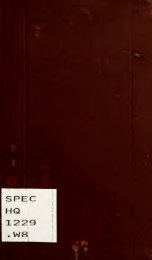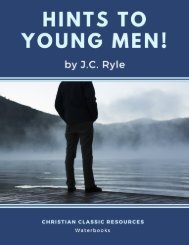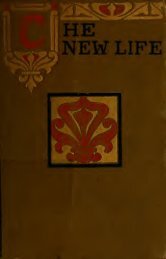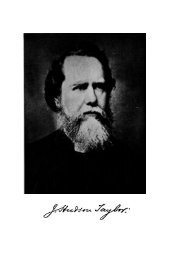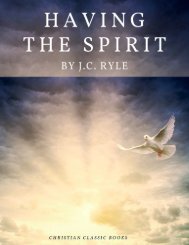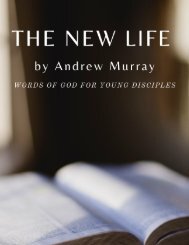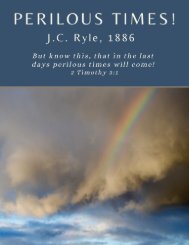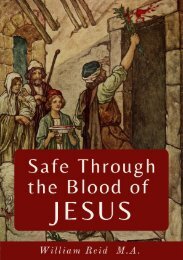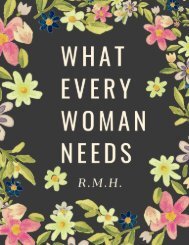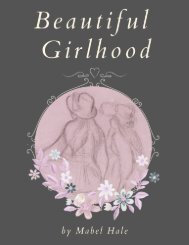- Page 2 and 3:
Ex Libris C. K. OGDEN
- Page 5:
Eminent Woinen Series EDITED BY JOH
- Page 8 and 9:
LONDON : PBIXTED BY W. H. ALLEN AND
- Page 10 and 11:
vi PREFACE. of what they wrote, and
- Page 12 and 13:
LIST OF AUTHORITIES. Memorials of t
- Page 14 and 15:
2 SUSANNA WESLEY. with a spice of s
- Page 16 and 17:
4 SUSANNA WESLEY. a saintly grandmo
- Page 18 and 19:
6 SUSANNA WESLEY. possibly being tu
- Page 20 and 21:
8 SUSANNA WESLEY. of figure to old
- Page 22 and 23:
10 SUSANNA WESLEY. Perhaps he sympa
- Page 24 and 25:
12 SUSANNA WESLEY. for he was engag
- Page 26 and 27:
14 SUSANNA WESLEY. read in their ch
- Page 28 and 29:
16 SUSANNA WESLEY. Fathers, but als
- Page 30 and 31:
18 SUSANNA WESLEY. his mother was d
- Page 32 and 33:
20 SUSANNA WESLEY. St. Dunstan's Ch
- Page 34 and 35:
22 SUSANNA WESLEY. CHAPTER IV. LATE
- Page 36 and 37:
24 SUSANNA WESLEY. in her own gener
- Page 38 and 39:
26 SUSANNA WESLEY. It was a rapid a
- Page 40 and 41:
28 SUSANNA WESLEY. How patiently sh
- Page 42 and 43:
30 SUSANNA WESLEY. was my principal
- Page 44 and 45:
32 SUSANNA WESLEY. ing timely corre
- Page 46 and 47:
34 SUSANNA WESLEY.
- Page 48 and 49:
36 SUSANNA WESLEY. should be always
- Page 50 and 51:
38 SUSANNA WESLEY. hardly have been
- Page 52 and 53:
40 SUSANNA WESLEY. (tithe?); and wh
- Page 54 and 55:
42 SUSANNA WESLEY. heir. Whether th
- Page 56 and 57:
44 SUSANNA WESLEY. CHAPTER VI. TRIA
- Page 58 and 59:
46 SUSANNA WESLEY. riding before hi
- Page 60 and 61:
48 SUSANNA WESLEY. authority, howev
- Page 62 and 63:
50 SUSANNA WESLEY. was the hero of
- Page 64 and 65:
52 SUSANNA WESLEY. Epworth, June 7t
- Page 66 and 67:
54 SUSANNA WESLEY. I thank God, my
- Page 68 and 69:
56 SUSANNA WESLEY. bring him in not
- Page 70 and 71:
58 SUSANNA WESLEY. 1 find I walk a
- Page 72 and 73:
'60 SUSANNA WESLEY. never intoxicat
- Page 74 and 75:
2 SUSANNA WESLEY. of duty towards a
- Page 76 and 77:
64 SUSANNA WESLEY. will not), and d
- Page 78 and 79:
66 SUSANNA WESLEY. " The eternal, e
- Page 80 and 81:
68 SUSANNA WESLEY. " Epworth, " DEA
- Page 82 and 83:
70 SUSANNA WESLEY. CHAPTER VIII. FI
- Page 84 and 85:
72 SUSANNA WESLEY. One can imagine
- Page 86 and 87:
74 SUSANNA WESLEY. and asked her fo
- Page 88 and 89:
76 SUSANNA WESLEY. to his window, w
- Page 90 and 91:
78 SUSANNA WESLEY. as one of the ha
- Page 92 and 93:
80 SUSANNA WESLEY. but I have thoug
- Page 94 and 95:
82 SUSANNA WESLEY. not been preserv
- Page 96 and 97:
84 SUSANNA WESLEY. the very birth o
- Page 98 and 99:
86 SUSANNA WESLEY. to enlighten you
- Page 100 and 101:
88 SUSANNA WESLEY. the purpose of b
- Page 102 and 103:
90 SUSANKA WESLEY. to the principle
- Page 104 and 105:
92 SUSANNA WESLEY. the Danish missi
- Page 106 and 107:
94 SUSANNA WESLEY. soon after the r
- Page 108 and 109:
96 SUSANNA, WESLEY. " Thursday, Dec
- Page 110 and 111:
98 SUSANNA WESLEY. " I am straitene
- Page 112 and 113:
100 SUSANNA WESLEY. CHAPTER X. TEAC
- Page 114 and 115:
102 SUSANNA WESLEY. rated a little,
- Page 116 and 117:
104 SUSANNA WESLEY. day, and not th
- Page 118 and 119:
106 SUSANNA WESLEY. read, alas ! yo
- Page 120 and 121:
108 SU8AXNA WESLEY. sermon read, wh
- Page 122 and 123:
110 SUSANNA WESLEY. The next event
- Page 124 and 125:
112 SUSANNA WE8LET. Both with equal
- Page 126 and 127:
114 SUSANNA WESLEY. variably preach
- Page 128 and 129:
116 SUSANNA WESLEY. body did it to
- Page 130 and 131:
118 SUSANNA WESLEY. parts of our ho
- Page 132 and 133:
120 SUSANNA WESLEY. course this let
- Page 134 and 135:
122 SUSANNA WESLEY. everything that
- Page 136 and 137:
124 SUSANNA WESLEY. failed to visit
- Page 138 and 139:
]26 SUSANNA WESLEY. any connection
- Page 140 and 141:
128 SUSANNA WESLEY. a favourable im
- Page 142 and 143:
130 SUSANNA WESLEY. so very difficu
- Page 144 and 145:
132 SUSANNA WESLEY. emerges from th
- Page 146 and 147:
134 SUSANNA WESLEY. ' success. He i
- Page 148 and 149:
136 SUSANNA WESLEY. even expected t
- Page 150 and 151:
138 SUSANNA WESLEY. the liberties i
- Page 152 and 153:
140 SUSANNA WESLEY. but I suppose t
- Page 154 and 155:
142 SUSANNA WESLEY. weighed with hi
- Page 156 and 157:
144 SUSANNA WESLEY. incident to men
- Page 158 and 159:
146 xrSANNA WESLEY. be able temptat
- Page 160 and 161:
148 SUSANNA WESLEY. santly in his l
- Page 162 and 163:
150 SUSANNA WESLEY. CHAPTER XIII. P
- Page 164 and 165:
152 SUSANNA WESLEY. will be, I beli
- Page 166 and 167:
154 SUSANNA WESLEY. published from
- Page 168 and 169:
156 SUSANNA WESLEY. properties and
- Page 170 and 171:
158 SUSANNA WESLEY. not recommend t
- Page 172 and 173:
160 SUSANNA WESLEY. afterwards he w
- Page 174 and 175:
162 SUSANNA WESLEY. the other, Mr.
- Page 176 and 177:
*64 SUSANNA WESLEY. over him, but i
- Page 178 and 179:
166 SUSANNA WESLEY. and figures acc
- Page 180 and 181: 168 SUSANNA WESLEY. childbed of her
- Page 182 and 183: 170 SUSANNA WESLEY. and that they h
- Page 184 and 185: 172 SUSANNA WESLEY. sense of that b
- Page 186 and 187: 174 SUSANNA WESLEY. " Your argument
- Page 188 and 189: 176 SUSANNA WESLEY. spiritual disea
- Page 190 and 191: 178 SUSANNA WESLEY. juncture I cann
- Page 192 and 193: 180 SUSANNA WESLEY. her husband's d
- Page 194 and 195: 182 SUSANNA WESLEY. CHAPTER XIV. WI
- Page 196 and 197: 384 SUSANNA WESLEY. and infirm moth
- Page 198 and 199: 186 SUSANNA WESLEY. consumed Ep wor
- Page 200 and 201: 188 SUSANNA WESLEY. method of preac
- Page 202 and 203: 190 SUSANNA WESLEY. our language an
- Page 204 and 205: 192 SUSANNA WESLEY. who is sufficie
- Page 206 and 207: 194 SUSANNA WESLEY. served faithful
- Page 208 and 209: 196 SUSANNA WESLEY. ing of a few ;
- Page 210 and 211: 198 SUSANNA WESLEY. your blessing u
- Page 212 and 213: 200 ^ SUSANNA WESLEY. indeed, is no
- Page 214 and 215: 202 SUSANNA WESLEY. And why is it s
- Page 216 and 217: 204 SUSANNA WESLEY. And thus the or
- Page 218 and 219: 206 SUSANNA WESLEY. let me rather g
- Page 220 and 221: 208 SUSANNA WESLEY. " She laboured
- Page 222 and 223: 210 SUSANNA WESLEY. not induce them
- Page 224 and 225: 212 SUSANNA WESLEY. CHAPTER XVI. SU
- Page 226 and 227: 214 SUSANNA WESLEY. A memorandum on
- Page 228 and 229: 216 SUSANNA WESLEY. on the " 7th, s
- Page 232 and 233: 220 SUSANNA WESLEY. person you ment
- Page 234 and 235: 222 SUSANNA WESLEY. Martha Wesley,
- Page 236 and 237: 224 SUSANNA WESLEY. me, wherein (by
- Page 238 and 239: 226 SUSANNA WESLEY. invariably give
- Page 240 and 241: 228 SUSANNA WESLEY. know a good dea
- Page 242 and 243: 230 SUSANNA WESLEY. Doctor, and sho
- Page 244 and 245: 232 SUSANNA WESLEY City Road Burial
- Page 246 and 247: 234 SUSANNA WESLEY. Sally, as she w
- Page 248 and 249: 236 SUSANNA WESLEY. Miss Wesley die
- Page 250 and 251: 238 SUSANNA WESLEY. one he was chos
- Page 252 and 253: LONDON : PRINTED BT W. H. ALLKN AND
- Page 254 and 255: OPINIONS OF THE PRESS. George Eliot
- Page 256: OPINIONS OF THE PRESS. Countess of




